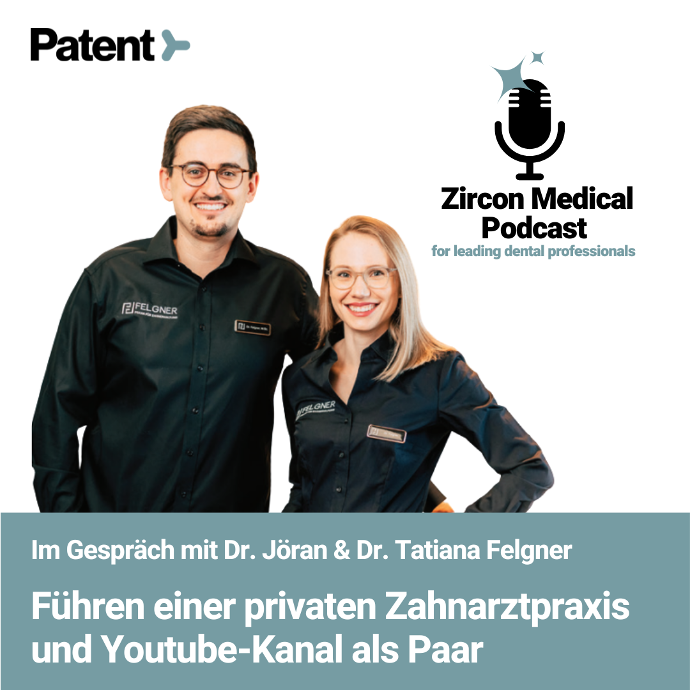Dr. Jöran Felgner & Dr. Tatiana Felgner
Co-Owners of Felgner Practice for Dental Preservation
Founded the practice in October 2019
Run a successful YouTube channel with over 11.5k subscribers
- Dr. Jöran Felgner specializes in endodontology
- Dr. Tatiana Felgner specializes in periodontology and implant therapy
- Website: https://www.zahnarztpraxis-felgner.de/
- Instagram: https://www.instagram.com/zahnarztpraxis.felgner
- Facebook: https://www.facebook.com/Zahnarztpraxis.Felgner
YouTube: https://www.youtube.com/channel/UCoLnApsuDAw_TO07rE4GAIQ
Eilenburger Str. 3, 04317 Leipzig, Germany
In Conversation with Dr. Jöran & Tatiana Felgner
Dr. Jöran & Tatiana Felgner are partners in more ways than one. They are life partners, business partners with a private dental practice in Leipzig, parents to a young girl, and they run a successful YouTube channel focused on patient education. Our team at Zircon Medical hosted the Felgners on our podcast series to discuss how they balance their responsibilities together.
Introducing the Felgners, the co-owners of a private dental practice in Leipzig
Dr. Jöran Felgner completed his dental education at TU Dresden, following which he was employed as a dentist in Berlin. He also completed a doctorate at the TU Dresden, where he became a research associate at the Department of Dental Preservation and Preventive Dentistry Charité Berlin. He also completed a master’s course in endodontology at the Düsseldorf Dental Academy & Heinrich Heine University.
Dr. Tatiana Felgner completed her dental degree from the HHU Düsseldorf, following which she became an assistant dentist in Berlin. She was also the research assistant in the department of Dental Preservation and Preventive Dentistry at Charité Berlin within the fields of aesthetic dentistry and digital dentistry. She also completed a curriculum on aesthetic dentistry at the Philipp Pfaff Institute Berlin and is currently completing a master’s course in periodontology and implant therapy from Dresden International University.
Dr. Jöran and Tatiana Felgner met in Berlin — they worked in the same department at the university. After working together for several years, they founded a dental practice called the Felgner Practice for Dental Preservation in Leipzig in 2019.
What it’s like to run a dental practice as a couple
When asked what it’s like to run a dental practice together, Dr. Tatiana said it’s cool because they get to spend a lot of time together and discuss ideas for the business over the breakfast table. In some cases, this can be an advantage, but it can also be a disadvantage. She occasionally wonders if it would have been better if they had different professions just to get a break from their work.
But overall, she says she’s happy to be working so closely with her life partner — they’re always working on projects together, which is fun! Dr. Jöran also concurs that he couldn’t imagine anyone else he’d rather run a practice with. Marriage is already a project; running a practice is yet another exciting project. Furthermore, both spouses have similar desires and expectations regarding jobs, aspirations, and motivation.
Establishing responsibilities and roles
Dr. Tatiana and Jöran have clear areas that they’re responsible for. Dr. Tatiana takes care of employees, and Dr. Jöran is more of a numbers guy. He handles issues regarding where to invest money, assigning budgets, working with tax consultants, and other issues related to numbers, figures, and data. Meanwhile, Dr. Tatiana focuses on handling employees, looking into duty rosters, distributing tasks between employees, and working with external service providers.
Furthermore, even within their skills and arenas as dentists, they have clear differences in responsibilities. Dr. Jöran specializes in microscopic endodontology, and Dr. Tatiana specializes in periodontology and aesthetic dentistry. Since they have clear responsibilities and arenas with decision-making powers, they can run the dental practice harmoniously. It also helps that they’re often of the same opinion and respect each other’s decisions.
Starting a YouTube channel together
The Felgners started producing videos to offer a little extra service to their patients. They wanted to explain the need for endodontic treatments, including the pros, cons, and risks, in an engaging manner. When patients are only told about aftercare in the office, they don’t retain all the information. The videos were designed to offer the patient an accessible avenue for information. The YouTube channel was initially supposed to be a practice internal video encyclopedia. They would guide patients to the relevant video for the information they needed.
When they started the YouTube channel, they didn’t care about accumulating subscribers. They simply wanted the channel to be a public database for information that could be shared with patients. Dentistry is pretty niche, Dr. Jöran says, and they didn’t have strong expectations from the channel. But as they started uploading videos, they resonated with people beyond their patients and soon started gaining new subscribers. They accumulated over 10k subscribers within a year.
Finding the time for YouTube
Dr. Tatiana says she was initially concerned about finding the time for a YouTube channel. They’re usually in practice from Monday to Friday, and they often tackle organizational issues on Saturday and Sunday. Because of such a busy schedule, she wasn’t sure when they’d find time to produce YouTube videos. But they somehow learned to schedule everything appropriately. They handle most YouTube projects on Saturdays and Sundays, and some friends help with post-production.
Dr. Tatiana says they spend considerable time writing a good script — one that would still resonate with people months or years down the line. Over time, as they produced videos, they also noticed that certain subjects and topics triggered more of a response than others. Videos related to chloride, for example, drew more of a reaction and engagement from the viewers. They’re thrilled that their viewers actively engage with the content and offer feedback.
Dr. Jöran says recording a video takes a maximum of half an hour per video. But most of the time is spent on preparing for the video. He starts preparing and writing the script a day before the recording. The scripting process takes one or two hours but varies from one video to the next. The videos that involve treatment documentation generally take a lot more time. According to Dr. Jöran, explainer videos are usually easier to produce and create.
Choosing the right topics for videos
Dr. Tatiana attributes their YouTube channel’s rapid growth to a bit of luck and selecting topical subjects. They started the channel with a reaction video. An influencer named Harrison had undergone an aesthetic dental treatment in Dubai — he had all of his teeth crowned. The reaction video delved into whether such an invasive procedure was necessary, what the ideal alternative would have been, and whether it’s a good idea to have so many teeth crowned in one week.
The Felgners don’t do complete crowns in their treatments. They only do partial crowns to preserve as much of the natural tooth as possible. To that end, they titled the video “why we never do crowns.” That instantly shot up the video’s engagement, which currently has over 600,000 views. The success of that one reaction video has also spilled over to all of their other videos. Dr. Tatiana says luck is a component, but the primary components of success are strategic topic selection and lots of hard work.
You can find Dr. Jöran and Tatiana Felgner in their dental practice in Leipzig. You can follow them online via Facebook or Instagram or watch their videos on their YouTube channel. You can also listen to them on the latest episode of our Zircon Medical Podcast.











